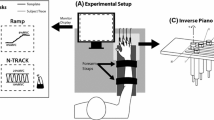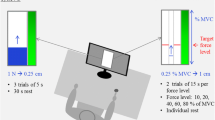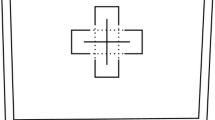Abstract
In a multifinger cyclic force production task, the finger force variance measured across trials can be decomposed into two components, one that affects the combined force output (“bad variance”) and one that does not (“good variance”). Previous studies have found similar time patterns of “bad variance” and force rate leading to an approximately linear relationship between them. Based on this finding and a recently developed model of multifinger force production, we expected the “bad variance” during cyclic force production to increase monotonically with the rate of force change, both within a cycle and across trials at different frequencies. Alternatively, “bad variance” could show a dependence on task frequency, not on actual force derivative values. Healthy subjects were required to produce cyclic force patterns to prescribed targets by pressing on unidimensional force sensors, at a frequency set by a metronome. The task was performed with only the index finger, and with all four fingers. In the task with all four fingers, the “good variance” increased approximately linearly with an increase in the force magnitude. The “bad variance” showed within-a-cycle modulation similar to that of the force rate. However, an increase in the frequency did not lead to an increase in the “bad variance” that could be expected based on the natural relationships between action frequency and the rate of force change modulation. The results have been interpreted in the framework of an earlier model of multifinger force production where “bad variance” is a result of variance of the timing parameter. The unexpected lack of modulation of the “bad variance” with frequency suggests a drop in variance of the timing parameter with increased frequency. This mechanism may serve to maintain a constant acceptable level of variance under different conditions.






Similar content being viewed by others
References
Danion F, Schöner G, Latash ML, Li S, Scholz JP, Zatsiorsky VM (2003) A mode hypothesis for finger interaction during multi-finger force-production tasks. Biol Cybern 88:91–98
Goodman SR, Latash ML (2006) Feed-forward control of a redundant motor system. Biol Cybern 95:271–280
Goodman SR, Shim JK, Zatsiorsky VM, Latash ML (2005) Motor variability within a multi-effector system: experimental and analytical studies of multi-finger production of quick force pulses. Exp Brain Res 163:75–85
Gorniak SL, Duarte M, Latash ML (2008) Do synergies improve accuracy? A study of speed accuracy trade-offs during finger force production. Motor Control 12:151–172
Hogan N, Sternad D (2007) On rhythmic and discrete movements: reflections, definitions and implications for motor control. Exp Brain Res 181:13–30
Ivry RB, Hazeltine RE (1995) Perception and production of temporal intervals across a range of durations: evidence for a common timing mechanism. J Exp Psychol Hum Percept Perform 21:3–18
Ivry RB, Richardson T (2002) Temporal control and coordination: the multiple timer model. Brain Cogn 48:117–132
Latash ML, Scholz JF, Danion F, Schöner G (2001) Structure of motor variability in marginally redundant multi-finger force production tasks. Exp Brain Res 141:153–165
Latash ML, Scholz JF, Danion F, Schöner G (2002a) Finger coordination during discrete and oscillatory force production tasks. Exp Brain Res 146:412–432
Latash ML, Scholz JP, Schöner G (2002b) Motor control strategies revealed in the structure of motor variability. Exerc Sport Sci Rev 30:26–31
Latash ML, Scholz JP, Schöner G (2007) Toward a new theory of motor synergies. Motor Control 11:275–307
Li ZM, Latash ML, Zatsiorsky VM (1998) Force sharing among fingers as a model of the redundancy problem. Exp Brain Res 119:276–286
Newell KM, Carlton LG (1988) Force variability in isometric responses. J Exp Psychol Hum Percept Perform 14:37–44
Schaal S, Sternad D, Osu R, Kawato M (2004) Rhythmic arm movement is not discrete. Nat Neurosci 7:1136–1143
Scholz JP, Schöner G (1999) The uncontrolled manifold concept: identifying control variables for a functional task. Exp Brain Res 126:289–306
Scholz JP, Danion F, Latash ML, Schöner G (2002) Understanding finger coordination through analysis of the structure of force variability. Biol Cybern 86:29–39
Shapkova EYu, Shapkova AL, Goodman SR, Zatsiorsky VM, Latash ML (2008) Do synergies decrease force variability? A study of single-finger and multi-finger force production. Exp Brain Res 188:411–425
Shim JK, Lay B, Zatsiorsky VM, Latash ML (2004) Age-related changes in finger coordination in static prehension tasks. J Appl Physiol 97:213–224
Sternad D, Dean WJ (2003) Rhythmic and discrete elements in multi-joint coordination. Brain Res 989:152–171
Yu H, Russell DM, Sternad D (2003) Task-effector asymmetries in a rhythmic continuation task. J Exp Psychol Hum Percept Perform 29:616–630
Zatsiorsky VM, Li ZM, Latash ML (1998) Coordinated force production in multi-finger tasks: finger interaction and neural network modeling. Biol Cybern 79:139–150
Zatsiorsky VM, Li ZM, Latash ML (2000) Enslaving effects in multi-finger force production. Exp Brain Res 131:187–195
Acknowledgments
The study was in part supported by NIH grants AG-018751, NS-035032, and AR-048563.
Author information
Authors and Affiliations
Corresponding author
Rights and permissions
About this article
Cite this article
Friedman, J., SKM, V., Zatsiorsky, V.M. et al. The sources of two components of variance: an example of multifinger cyclic force production tasks at different frequencies. Exp Brain Res 196, 263–277 (2009). https://doi.org/10.1007/s00221-009-1846-x
Received:
Accepted:
Published:
Issue Date:
DOI: https://doi.org/10.1007/s00221-009-1846-x




